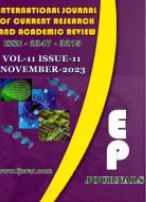Abstract Volume:11 Issue-11 Year-2023 Original Research Articles
 |
Online ISSN : 2347 - 3215 Issues : 12 per year Publisher : Excellent Publishers Email : editorijcret@gmail.com |
Campylobacter spp. is a zoonotic bacterium and it cause human gastroenteritis in worldwide and main symptom is diarrhoea. Campylobacter infection includes bloody diarrhoea, abdominal pain, fever, malaise, nausea, and rarely vomiting. Complications include intestinal haemorrhage, toxic megacolon, haemolytic uraemic syndrome and mesenteric adenitis in the longer-term infection, other clinical manifestations are meningitis, bacteraemia, localized extra intestinal infections, immune-reactive complications such as reactive arthritis and neurological sequelae. The major transmission routes of Campylobacteriosis in humans are consumption of contaminated or undercooked meat. Campylobacter species are widely spread in most warm-blooded animals because of its high body temperature (41?) which is conducive to its growth making it an important reservoir. In this study we aimed to isolate the Campylobacter spp. in goat intestine. The isolates were identified on the basis of polymerase chain reaction (PCR) detection and multiplex PCR to determine the species. Totally 70 goat caecal contents were collected from various places in Chennai. Bacterial isolation was done by plating on blood free Campylobacter selective medium with supplements for an incubation period of three to six days using bacterial culture, presumptive identification was done by dilute carbol fuchsin staining, oxidase and catalase test was performed. DNA extraction was done by boiling method. The colony multiplex PCR are identified a Campylobacter spp. by using the Wang primer for DNA amplification. Campylobacter jejuni detected at the length of 650bp. Out of 70 samples, 38 samples were found positive for C.jejuni by multiplex PCR. Campylobacter jejuni isolates were tested for 11 virulence genes by PCR. Out of 38 positive samples, randomly selected four isolates were tested for virulence gene profiling. Virulence genes are showed the genes involved in motility (flaA and flaB), invasion (ciaB, ceuE), and cytotoxin production (cdtA, cdtB, cdtC) and cell adhesion factor (cadF, pldA, racR and dnaJ). Virulence gene detection of four random isolates of Campylobacter jejuni showed the virulence of cadF, dnaJ, cdtA, ciaB, pldA, flaA and flaB are showing 100% positive results and racR showing 75%, cdtC and ceuE showing 25% positive, cdtB showing negative result for virulence gene profiling. To confirm Campylobacter jejuni 16S rRNA sequence which was amplified by using Wang primer of 650 kbp size. The PCR product was submitted for gene sequencing. The sequence which was checked for similarity by using NCBI-BLAST.
How to cite this article:
Parvathi, M. and Louis M. R. Lima Mirabel. 2023. Prevalence and Molecular Detection of Campylobacter Species Isolated from Goat Intestine.Int.J.Curr.Res.Aca.Rev. 11(11): 51-58doi: https://doi.org/10.20546/ijcrar.2023.1111.006



Quick Navigation
- Print Article
- Full Text PDF
- How to Cite this Article
- on Google
- on Google Scholor
- Citation Alert By Google Scholar
